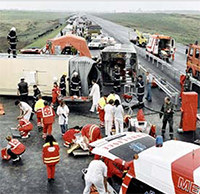BCP Workbook
Business Continuity Plan Workbook
The Survive and Then Thrive Continuity Planning Workbook is a step by step guide to direct you in developing a plan that works for your business, non-profit or faith-based organization. It is based on proven formats that guide decision-making to direct actions that focus on the foundation or essential aspects of your operations.
Two exclusive components of our planning system are the integration of continuity planning into ongoing operations and the incorporation of strategic planning elements in current and future decision-making.
Each chapter addresses a different set of decisions that you need to make concerning how you are going to continue to operate during a crisis so that you can emerge from the situation stronger.
Chapters explain the reasons behind the decisions to be made and then guide you through the decision-making process for each step. Forms are provided to capture your decisions.
The forms in the Workbook build upon one another and become the backbone of your Continuity Plan. When activating the plan, you go directly to the forms to quickly determine the actions to take. Decisions have been made in advance, and personnel know what they need to do. This enables you to act quickly and appropriately, keeping your organization operating in times of crisis.
A unique aspect of this continuity planning is that each step includes suggestions and directions on integrating the continuity plan into ongoing operations. This makes your organization more resilient and better able to withstand any crisis. Integrating preparedness into daily operations keeps the potential for dealing with disasters at the forefront and enables leaders to enter continuity mode quickly and easily.
The integration of the continuity plan into ongoing operations also ensures that the plan is constantly updated and accurate. For example, identifying someone who resigned two years ago as an essential employee is not helpful during a crisis. Calling someone at a phone number that changed six months ago is futile. Updating the information regarding essential continuity employees at the same time that it is updated in personnel files is a simple example of integrating the continuity plan into ongoing operations. These small adjustments to operation protocol keep the continuity plan current and integrate the concept of preparedness, of being ready, into the normal routine of doing business in your organization.
If you follow the steps in the Continuity Planning Workbook you will develop a plan that becomes part of your operations and enables you to quickly respond to crisis in a way that keeps your essential functions operating. Because you have prioritized your essential functions, you will be able to survive a crisis and then, as you make adjustments getting back to full operations, you can thrive as you come back even stronger.
The Business Continuity Planning Workbook is priced to be affordable to the smallest businesses and to non-profits and faith-based organizations operating on shoestring budgets. It is a worthwhile investment that demonstrates serious commitment to ongoing operations.
If you want to stay in business and continue to serve, invest in Continuity Planning today. Capture the lessons you have learned and prepare for a stronger response to the next crisis. Make preparedness part of who you are and what you do. Stay in business, keep operating during any disaster that comes and emerge stronger, better able to deal with changing demands from your customers and clients.

75% of small businesses do not have a disaster recovery plan in place

52% of small businesses say it would take at least three months to recover from a disaster
Only 18% of companies surveyed that have fewer than 50 employees have a disaster recovery plan

Only 25% of businesses that close due to a major disaster ever reopen



